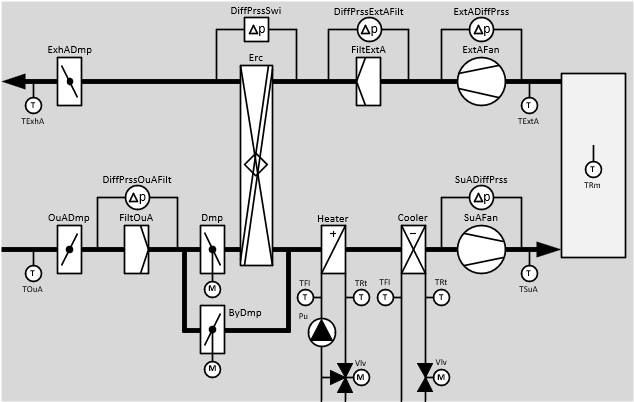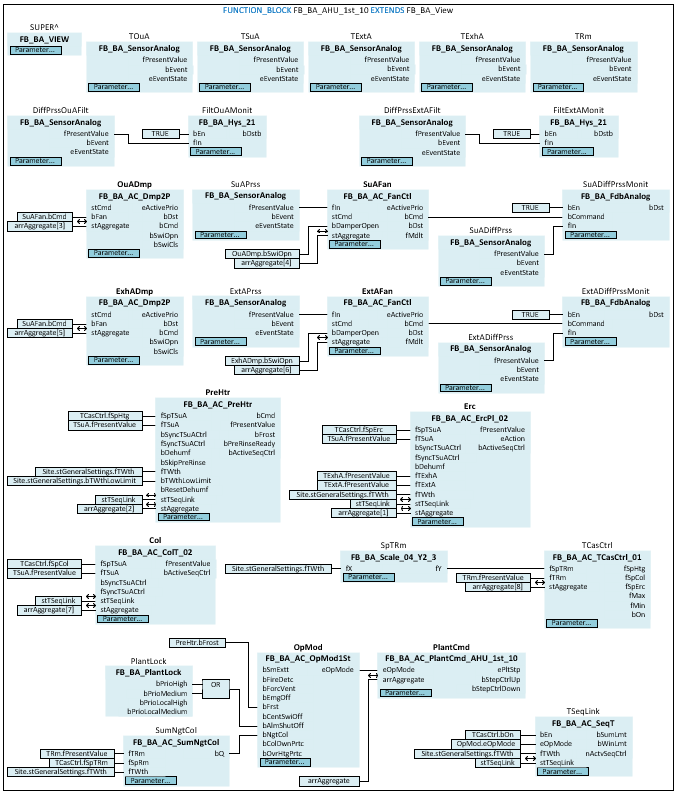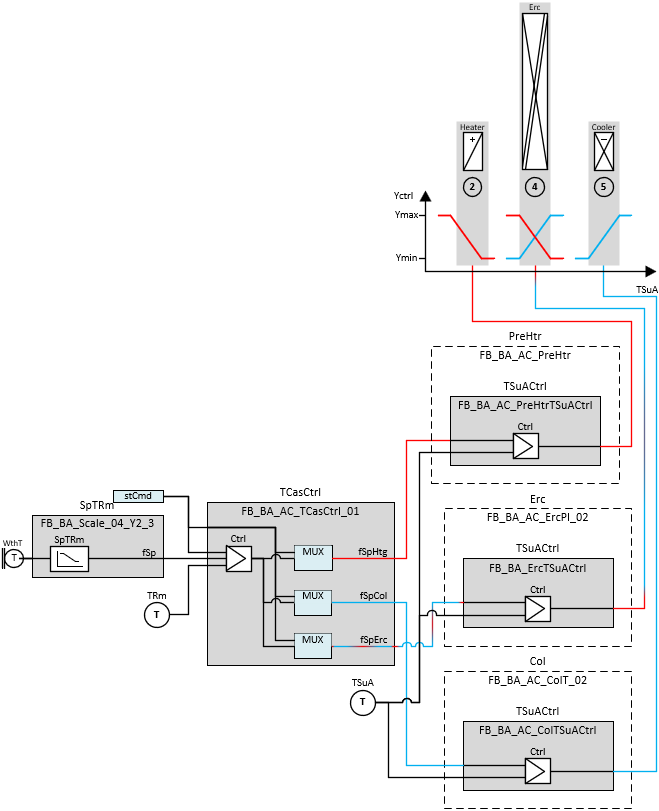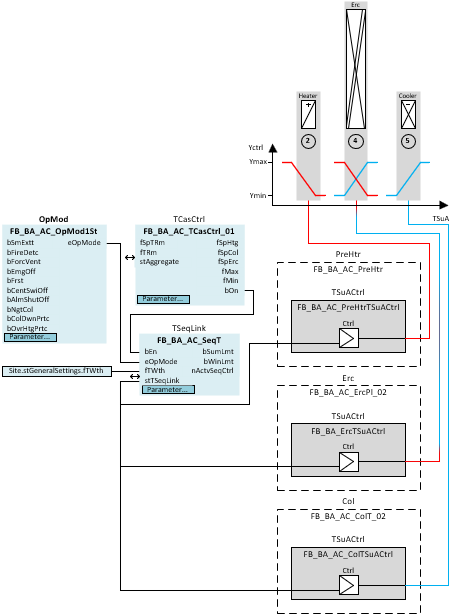FB_BA_AHU_1st_10

Template of an air conditioning system.
The main components of the template are:
- Plant control and start program
- Supply air temperature sequence control
- Room temperature cascade control
- Summer night cooling
- Pressure control of the supply and extract air fan
- Thermal air treatment using air heaters, coolers and energy recovery by means of plate heat exchangers
- External and exhaust air damper with spring return actuator and end position monitor
- External and extract air filters with analog differential pressure monitoring

 | The initialization of the template takes place within the method FB_Init. |
Block diagram

Plant diagram

Switch-on sequence of the aggregates of the plant
Within PlantCmd, a step sequence controller sequentially controls the switching on and off of the aggregates one after the other. When switching from aggregate to aggregate, predefined delay times and feedback from the aggregates are taken into account.
The order of the aggregates is determined by the ordinal number of the individual elements of the bidirectional array arrAggregate.

Step | Stages of plant start-up | Aggregate | Function blocks |
|---|---|---|---|
00 | E_BA_AC_PlantStep01.eOff | Plant Off |
|
01 | E_BA_AC_PlantStep01.eErc | Energy recovery | Erc |
02 | E_BA_AC_PlantStep01.ePreRinse | Prerinsing of the hot water air heater | PreHtr |
03 | E_BA_AC_PlantStep01.eDamperOuA | Outside air damper | OuADmp |
04 | E_BA_AC_PlantStep01.eFanSupplyAir | Supply air fan | SuAFan |
05 | E_BA_AC_PlantStep01.eDamperExhA | Exhaust air damper | ExhADmp |
06 | E_BA_AC_PlantStep01.eFanExtractAir | Extract air fan | ExtAFan |
07 | E_BA_AC_PlantStep01.eCooler | Cold water air cooler | Col |
08 | E_BA_AC_PlantStep01.eOn | Room supply air cascade, plant On | TCasCtrl |
If the plant has reached step 08 E_BA_AC_PlantStep01.eOn, the supply air temperature sequence control TSeqLink is enabled when the cascade control TCasCtrl is switched on.

Starting up the plant in cold weather
When the system is switched on in cold weather, the step sequence control of the PlantCmd command includes the plant step PreRinse of the preheater E_BA_AC_PlantStep01.ePreRinse. In this step, the return temperature control of the hot water air heater is activated. This procedure is intended to prevent the freezing of the hot water air heater during the plant start-up.
Fault shutdown
The plant switches off at:
- Fire alarm
- Frost alarm
NOTICE
- Fan faults (feedback monitoring, thermoelectric overload, maintenance switch)
- Incorrect position of the outside and exhaust air damper.
- Filter blockages
The following table lists the event-capable objects of the template that can trigger relevant PlantLock faults. The parameterization of these events can be found in FB_init.
Function block | eEnPlantLock | Function block | bPrioHigh | bPrioMedium |
|---|---|---|---|---|
TSuA.MV | E_BA_LockPriority.eMedium |
PlantLock |
| x |
FiltOuAMonit.DstMainAlarm
| E_BA_LockPriority.eMedium |
| x | |
OuADmp.MonitOpen.Dst | E_BA_LockPriority.eMedium |
| x | |
SuAFan.Dst | E_BA_LockPriority.eMedium |
| x | |
SuAFan.ThOvrld | E_BA_LockPriority.eMedium |
| x | |
SuAFan.MntnSwi | E_BA_LockPriority.eMedium |
| x | |
SuADiffPrssMonit.Dst | E_BA_LockPriority.eMedium |
| x | |
ExhADmp.MonitOpen.Dst | E_BA_LockPriority.eMedium |
| x | |
ExtAFan.Dst | E_BA_LockPriority.eMedium |
| x | |
ExtAFan.ThOvrld | E_BA_LockPriority.eMedium |
| x | |
ExtAFan.MntnSwi | E_BA_LockPriority.eMedium |
| x | |
ExtADiffPrssMonit.Dst | E_BA_LockPriority.eMedium |
| x | |
PreHtr.TRt.MV | E_BA_LockPriority.eMedium |
| x | |
PreHtr.TFrost.MV | E_BA_LockPriority.eMedium |
| x | |
PreHtr.FrostThermostat.Input | E_BA_LockPriority.eMedium |
| x | |
PreHtr.Pu.Dst | E_BA_LockPriority.eMedium |
| x |
The parameterization of the lock priority of the event-enabled objects can be found in the FB_init of this template.
Temperature control
In this plant template a simple room air supply air cascade is realized as control strategy.
The setpoints for the plant are generated in the templates SpTRm / TCasCtrl and forwarded to the sequence controllers within the templates PreHtr, Col and Erc.

Sequence control
The number of sequence controllers in the control sequence varies and depends on the number of aggregates in the ventilation system. The PID sequence controllers, which contribute to increasing the supply air temperature, are arranged on the left of the control sequence. The controllers of the aggregates that cool down the supply air temperature are located on the right.
Several heating or cooling aggregates can be integrated into the control sequence.
Only one PID controller is active at any one time in the sequence control. All others remain at the value of their maximum or minimum control value.

The sequence control TSeqLink is enabled when bOn is received from the cascade control TCasCtrl.
The start sequence controller with which the plant starts up is determined depending on the weather temperature Site.stGeneralSettings.fTWth or the operation mode OpMod.
The stTSeqLink data structure is used to transmit the plant enable and the number of the start controller to the sequence controllers of the PreHtr air heater, Col air cooler and Erc energy recovery unit.
The ventilation system in the sequence diagram is equipped with an air heater, an energy recovery unit and an air cooler.
All aggregates are integrated into a sequence controller for continuous control of the supply air temperature TSuA at very low outdoor temperatures in winter through to high outdoor temperatures in summer.
The sequence on the left starts with the control range of the PreHtr air heater. At low outside temperatures, the output of the air heater is increased until the supply air temperature TSuA has reached its setpoint.
If the outside temperature TOuA rises, the sequence controller TSuACtrl of the PreHtr air heater reduces its actuating variable until it reaches the lower limit of its control range.
If the setpoint of the supply air temperature TCasCtrl is still not reached, the sequence controller TSuACtrl of the air heater PreHtr switches to the sequence controller TSuACtrl of the energy recovery Erc.
The behavior of the energy recovery Erc depends on the ratio of the weather temperature Site.stGeneralSettings.fTWth and the extract air temperature TExtA.
If the weather temperature Site.stGeneralSettings.fTWth is lower than the extract air temperature TExtA, energy recovery recovers heat energy from the extract air and transfers it to the outside air. The red characteristic curve is then activated in the control sequence.
The control direction of the sequence controller TSuACtrl is therefore indirect (heating mode).
In summer, the extract air temperature is often lower than the weather temperature. The energy flow of the energy recovery Erc is then inverted. The heat from the outside air is transferred to the exhaust air TExhA and the supply air temperature is reduced as a result. In this operating case, the sequence follows the blue characteristic curve. The control direction of the sequence controller TSuACtrl is therefore direct (cooling mode).
At high outside temperatures, if the recovery capacity of the Erc is not sufficient to cool the outside air OuA down far enough, the sequence controller TSuACtrl of the energy recovery Erc switches on to the sequence controller TSuACtrl of the cooler Col. This increases the capacity of the cooler until the setpoint of the supply air temperature is reached.
Filter monitoring
The outside and extract air filters are monitored via the function blocks FiltOuAMonit and FiltExtAMonit with the analog differential pressure sensors DiffPrssOuAFilt / DiffPrssExtAFilt. The filter monitors are enabled when bOn is received from the cascade control TCasCtrl.
Night cooling
Night cooling can be controlled via the function block SumNgtCol.
Syntax
FUNCTION_BLOCK FB_BA_AHU_1st_10 EXTENDS FB_BA_View
VAR_INPUT CONSTANT
TOuA : FB_BA_SensorAnalog;
TExhA : FB_BA_SensorAnalog;
TSuA : FB_BA_SensorAnalog;
TExtA : FB_BA_SensorAnalog;
TRm : FB_BA_SensorAnalog;
DiffPrssOuAFilt : FB_BA_SensorAnalog;
FiltOuAMonit : FB_BA_Hys_21;
DiffPrssExtAFilt : FB_BA_SensorAnalog;
FiltExtAMonit : FB_BA_Hys_21;
OuADmp : FB_BA_AC_Dmp2P;
SuAPrss : FB_BA_SensorAnalog;
SuADiffPrss : FB_BA_SensorAnalog;
SuAFan : FB_BA_AC_FanCtl;
SuADiffPrssMonit : FB_BA_FdbAnalog;
ExhADmp : FB_BA_AC_Dmp2P;
ExtAPrss : FB_BA_SensorAnalog;
ExtADiffPrss : FB_BA_SensorAnalog;
ExtAFan : FB_BA_AC_FanCtl;
ExtADiffPrssMonit : FB_BA_FdbAnalog;
PreHtr : FB_BA_AC_PreHtr;
Erc : FB_BA_AC_ErcPl_02;
Col : FB_BA_AC_ColT_02;
SpTRm : FB_BA_Scale_04_Y2_3;
TCasCtrl : FB_BA_AC_TCasCtrl_01;
SumNgtCol : FB_BA_AC_SumNgtCol;
OpMod : FB_BA_AC_OpMod1St;
EnPrio : FB_BA_AC_EnPrio;
PlantLock : FB_BA_PlantLock;
PlantCmd : FB_BA_AC_PlantCmd_AHU_1st_10;
TSeqLink : FB_BA_AC_SeqT;
stTSeqLink : ST_BA_SeqLink;
arrAggregate : ARRAY [1..BA_Param.nMaxAggregate] OF ST_BA_Aggregate;
END_VAR VAR_INPUT CONSTANT
VAR_INPUT CONSTANT
Name | Type | Description |
|---|---|---|
TOuA | Represents the outside air temperature | |
TExhA | Represents the exhaust air temperature | |
TSuA | Represents the supply air temperature | |
TExtA | Represents the extract air temperature | |
TRm | Represents the room temperature | |
DiffPrssOuAFilt | Analog differential pressure via the outside air filter | |
FiltOuAMonit | Analog monitoring of the outside air filter. The filter monitoring uses the analog differential pressure DiffPrssOuAFilt and can trigger both a pre-alarm and a main alarm. | |
DiffPrssExtAFilt | Analog differential pressure via the extract air filter | |
FiltExtAMonit | Analog monitoring of the extract air filter. Filter monitoring uses the analog differential pressure FiltExtAMonit and can trigger both a pre-alarm and a main alarm. | |
OuADmp | Activation of the outside air damper with a spring return actuator and end position monitor. | |
SuAPrss | Supply air pressure | |
SuADiffPrss | Differential pressure via the supply air fan | |
SuAFan | Activation and control of the speed-controlled supply air fan. | |
SuADiffPrssMonit | Analog differential pressure monitoring via the supply air fan. | |
ExhADmp | Control of the exhaust air damper with a spring return actuator and end position monitor. | |
ExtAPrss | Extract air pressure. | |
ExtADiffPrss | Differential pressure via the extract air fan | |
ExtAFan | Control and regulation of the speed-controlled extract air fan. | |
ExtADiffPrssMonit | Analog differential pressure monitoring via the extract air fan. | |
PreHtr | Activation and control of a hot water air heater. | |
Erc | Activation and control of a plate heat exchanger for the energy recovery of a ventilation system. | |
Col | Activation and control of a temperature-controlled cold water air cooler. | |
SpTRm | Setpoint program for supply air temperature control with a supply air temperature setpoint, including summer/winter compensation via a characteristic curve. | |
TCasCtrl | Room temperature control by means of room-supply air cascade. It consists of a master controller for setpoint calculation for heating, cooling and energy recovery. | |
SumNgtCol | Night cooling control | |
OpMod | The function block is used to switch on the plant. It represents the choice of plant operation mode, a timer program and a plant selector switch. | |
EnPrio | Defines the plant release for controlling the step sequence control of a plant and the release of the priorities "Safety", "Critcial" and "Program" based on the plant operation mode OpMod. These releases are transferred to PlantCmd. | |
PlantLock | When the function block is called, the relevant faults of the event-enabled objects are collected and output at this and lower levels of the plant. These relevant faults trigger the operation mode Fault E_BA_AC_OpMod01.eAlarm in the operation mode program OpMod. As a result, the air conditioning system is shut down. A list of the faults that shut down the plant can be found under Fault shutdowns. | |
PlantCmd | The function block represents the plant command of the aggregates and functions of this air conditioning system. The integrated step sequence controller fixes the order in which the individual aggregates of the plant are switched on or off sequentially one after the other. | |
TSeqLink | Represents the start and control of the supply air temperature sequence control. | |
stTSeqLink | Data and command structure between the individual sequence controllers of the temperature control sequence PreHtr, Col, Erc and the supply air temperature sequence control TSeqLink. | |
arrAggregates | The array contains a bidirectional data and command structure for each aggregate. |
Requirements
Development environment | Necessary function |
|---|---|
TwinCAT from v3.1.4024.56 | TF8040 | TwinCAT Building Automation from V5.8.0.0 |